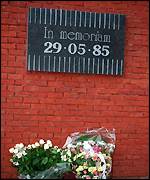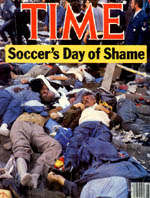Articles
A Liverpool view of the Heysel Stadium Tragedy
Having finally got into the stadium, further reasons for the turnstile chaos immediately presented themselves. Just beyond the turnstile, a water pipe had fractured, turning the area into a sea of reddy brown mud, in which floated endless crushed paper cups and empty cans, discarded wrappers from chocolate bars and bags of crisps and other unidentifiable debris. A red Liverpool FC cap lay forlornly semi-submerged. The mud lake was too wide to jump across, so wading was the only alternative. The result: apart from spattered jeans and squelchy shoes and socks, it meant a build-up of bodies just beyond the turnstile, restricting the smooth flow of supporters into the ground from outside, at the precise time and place where the crowd pressure was greatest.
Once over the water jump, the next obstacle was a choking, swirling cloud of red dust, as the decrepit building’s foundations were scuffed into life by the stampede of thousands of pairs of feet. Ahead of us, partly no doubt as a result of the cavalier approach to ticket control and ground admission, the terracing was a solid, impenetrable Red Sea with no parting –– and there were still thousands outside waiting to get in, most presumably possessing genuine match tickets and assuming there would be space for them. But they, like us, would have to lever their way through, prising bodies apart and wedging their own into the tiny gap created, which would snap shut instantly behind them as they pushed forwards another few inches in the sweltering body heat. On some of the crush barriers, the concrete had crumbled away to reveal the exposed metal reinforcing strips inside, rusted and twisted.
 We felt an acute sense of disappointment at the standard of the venue; this stadium did not make it feel like European football’s grandest occasion. You expect to be impressed, awestruck by the sense of occasion; I thought back to the grandeur and pageant of the Stadio Olimpico in Rome, the inspiring first impressions and the explosion of sound and vision created by Liverpool’s army of fans. In stark contrast, the inglorious Heysel felt second-rate, squalid, shorn of style and class, and with feeble organisation to compound it.
We felt an acute sense of disappointment at the standard of the venue; this stadium did not make it feel like European football’s grandest occasion. You expect to be impressed, awestruck by the sense of occasion; I thought back to the grandeur and pageant of the Stadio Olimpico in Rome, the inspiring first impressions and the explosion of sound and vision created by Liverpool’s army of fans. In stark contrast, the inglorious Heysel felt second-rate, squalid, shorn of style and class, and with feeble organisation to compound it.
We finally found a position where we could see what should have been the green of the pitch. Instead, we saw that the entire near right-hand quarter of the vivid green playing surface had been engulfed by a human spillage of epic scale –– a tangled mass of fans, police, stewards, officials, paramedics and photographers. We took this as nothing more than yet another manifestation of overcrowding and organisational incompetence. After all the chaos, Don began to lose patience, with which he probably isn’t over-blessed: “For fuck’s sake sort yourselves out, this is shite”, he yelled across the terraces.
“There’s been a bit of bother in that corner lad, a crowd surge or something, a bit of fighting like”, came a voice from behind. If the match was to start on time in twenty five minutes –– 20.15 kick-off in those days –– there was an awful lot of clearing up to do. In the UK, a TV audience of millions was finishing dinner, fetching beer from the fridge and settling down to watch the football. But what they, and millions more across Europe and across the globe, saw and heard instead were the first harrowing images of people dying at a football match. Replay after replay of clashes and charges between rival supporters was being shown, interspersed with an ever-rising fatalities figure. Around the globe, newsrooms sparked into frenzied activity, phones and faxes chattering excitedly as a major news story broke. Yet we inside the Heysel Stadium, only yards from the eye of the hurricane, had much less idea of the gravity of the situation than most of the rest of Europe who were watching. No commentary, no replays, no access to TV or the authorities to feed us information, certainly no rumours of deaths yet, just speculation. Still oblivious to the nature and scale of the incident, we remained the calmest and least horrified of observers. I’m sure it looked incredibly callous, but we just didn’t know. We just wanted the pitch cleared so the European Cup Final could start, and grew more agitated with the authorities’ apparent inability to get even that right.
 Despite the frenzied scurrying and frantic arm-waving of the assembled legions of arm-banded officials, police and the advance guard of the army, the situation seemed not to change for what felt like an eternity. Their hyperactivity contrasted sharply with the unnatural calm that had settled over the red mass of supporters. With kick-off so close, excitement levels should have been approaching critical. Instead we waited in silence for news, explanation or action, or at least some visible signs of progress. Kick-off, if indeed there was going to be one, would clearly be considerably delayed, opening up the additional complication of probably missing our last train back to Ostend.
Despite the frenzied scurrying and frantic arm-waving of the assembled legions of arm-banded officials, police and the advance guard of the army, the situation seemed not to change for what felt like an eternity. Their hyperactivity contrasted sharply with the unnatural calm that had settled over the red mass of supporters. With kick-off so close, excitement levels should have been approaching critical. Instead we waited in silence for news, explanation or action, or at least some visible signs of progress. Kick-off, if indeed there was going to be one, would clearly be considerably delayed, opening up the additional complication of probably missing our last train back to Ostend.
A man wearing a Liverpool shirt suddenly appeared on the running track surrounding the pitch, hotly pursued by another supporter. After being chased for nearly half the length of the pitch, he was felled by a brick to the head. The pursuing police seized the chasee –– though not the chaser –– and frogmarched him away with highly visible and almost over-compensatory firmness for their hitherto supine response. Cops chasing fan chasing fan, it was a farce that belonged more to The Benny Hill Show than the European Cup Final.


